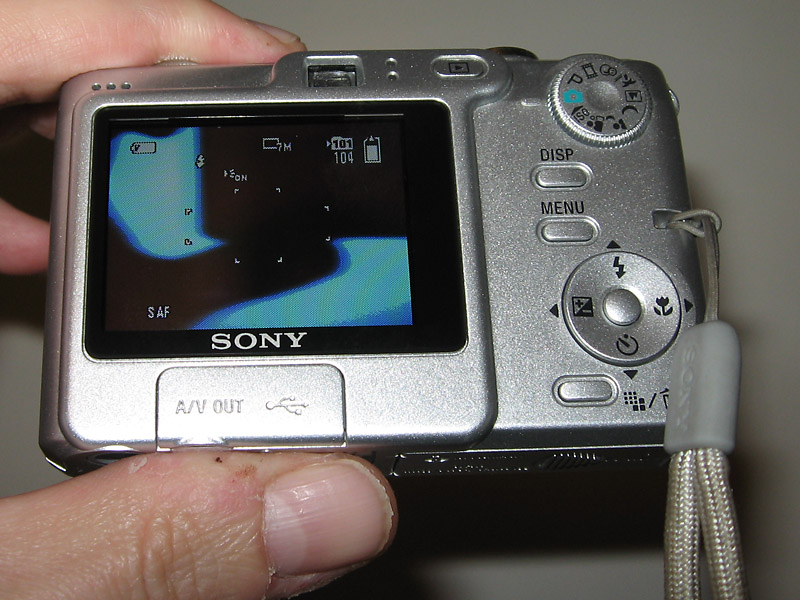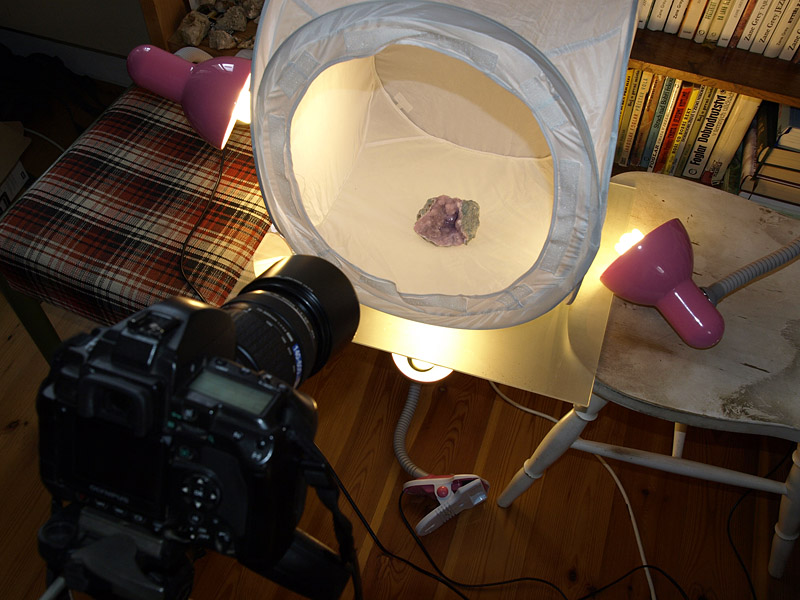First you need to sum up all your needs, there is no all in one equipment. Most users shoot minerals from thumbnail size up to large cabinets. There are two ways to solve this. The easier way is to use quality P&S (point and shoot) camera, it is easy to handle, cheap and small. The DSLR (digital single reflex camera) is more expensive and complicated option but it is very versatile and delivers significantly better image quality.
Choosing P&S camera
Avoid all those credit card sized junk or 30x zoom stuff and look for decent model. It needs manual focus, manual exposure mode, good white balance, solid lens (usually 3-5x zoom), decent macro abilities and better it shoots in RAW. I do not recommend going over 12 megapixels with P&S. Remember that quality is NOT equal to zoom, megapixels or highest ISO possible!


Typical small P&S camera from Sony. These types have 3-5x zoom, huge resolution and bad or mediocre image quality. Avoid these or ultrazoom cameras, their performance is usually quite bad and they lack basic things like manual exposure, manual ISO settings, custom white balance, filter screw and tripod mount, which are necessary for mineral photography.
Advanced models seem to be pretty simple and expensive compared to 3x cheaper models with zillion megapixels and 30x zoom. You bet there is a good reason for the price. Advanced P&S cameras have much better optics and image quality and you can set many features manually. Many of them also have wide variety of extra gadgets like filters, diopters, external flash unit etc. Most of cheap P&S cameras lack manual exposure mode, manual focus mode, filter screw and tripod mount. This is not a problem for holiday snapshots but it is very bad for serious mineral photography. Advanced P&S cameras often costs the same as cheap DSLR kits and probably will be soon extinct because of mirror-less systems.
Choosing DSLR
Generally all modern DSLR cameras are good enough. (While DSLR technically means mirror-equipped camera, we will consider also all mirror-less systems with interchangable lenses to be DSLR.) Choosing brand however limits your lenses and accessories available so better think twice. You cannot misstep with either Nikon or Canon, other manufacturers like Sony, Pentax, Olympus, Panasonic, Samsung and Sigma have certain limitations.

My old DSLR with ultra-wide lens. Of course this lens is not used for mineral photography.
I recommend rather buying good lens and cheaper body then opposite. Most bodies up to semi-pro models usually have exactly the same sensor. The difference is in the construction, sealing and special functions, not in image quality! But even beginner will instantly see the difference between cheap and good lens.
Choosing lenses for DSLR
If you buy DSLR for shooting minerals, avoid cheap kit lenses and better get some decent macro lens. Kit lenses are poor macro performers and most of them lack good optics. Macro lenses around 90-100 mm work best, deliver tack sharp results and you can use them for anything between thumbnails and large clusters. You will also need a macro ring or diopters for shooting really small things.

Some of my old M42 screw mount lenses. I often use them for macrophotography of minerals.
Other option is to get decent zoom, these are more versatile while the results are slightly less impressive then from macro lenses. Most short tele lenses like popular 70-200 will work just fine. Surprisingly even common 70-300 zooms work pretty fine. You will need macro ring or diopters to shoot thumbnails or smaller.
Better think twice before buying lens, check all options, read reviews and try the lens in the shop before purchasing. You often notice some features or behavior not mentioned in any review. You are not buying lens for just a year or two!
Final word
I highly recommend reading some reviews and testing in person before buying, it will save you a lot of headache later. It is also very wise to invest a bit more or your skills will grow over your camera very quickly and purchasing another one within a year might be more expensive in the end. Do not blindly follow the advice from the seller or friends and make your own opinion. The most expensive option is not necessarily the best one but buying cheapest junk isn’t solution either!

Leave a Reply